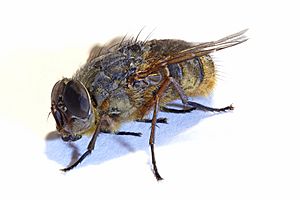Brown blowfly facts for kids
Quick facts for kids Brown blowfly |
|
|---|---|
 |
|
| Scientific classification | |
| Kingdom: | |
| Phylum: | |
| Class: | |
| Order: | |
| Family: | |
| Genus: |
Calliphora
|
| Species: |
C. stygia
|
| Binomial name | |
| Calliphora stygia (Fabricius, 1781)
|
|
The brown blowfly, known scientifically as Calliphora stygia, is a common type of blowfly. It is also called rango tumaro in the Māori language. This fly is found in Australia and New Zealand. It has a grey upper body (called a thorax) and a yellow-brown lower body (called an abdomen).
Contents
What is a Brown Blowfly?
Brown blowflies are medium-sized flies. They are usually about 6 to 12 millimeters long. Their bodies are often shiny and metallic-looking. They have large red eyes and clear wings.
Where Do Brown Blowflies Live?
You can find brown blowflies all over Australia and New Zealand. They live in many different places. This includes cities, farms, and natural areas. They are very adaptable and can survive in various environments.
Their Important Role in Nature
Brown blowflies play a key role in nature. They are like nature's clean-up crew. These flies are attracted to dead animals. They help break down these materials. This process is called decomposition. It helps recycle nutrients back into the environment.
How They Help the Environment
When an animal dies, brown blowflies are often among the first insects to arrive. They can find dead animals very quickly. This is important because they start the process of breaking down the body. Their activity helps prevent the build-up of dead organic matter.
The Life Cycle of a Blowfly
Like all flies, brown blowflies go through a complete life cycle. This includes four stages: egg, larva, pupa, and adult.
- Eggs: Adult female flies lay tiny white eggs. They usually lay them on dead animals or other decaying materials.
- Larvae: The eggs hatch into larvae, which are also called maggots. These maggots are worm-like. They feed on the decaying material. They grow quickly.
- Pupae: After growing enough, the larvae change into pupae. This is a resting stage. The pupa forms a hard case around itself. Inside, the maggot transforms into an adult fly.
- Adults: Finally, an adult fly emerges from the pupal case. The adult fly will then find a mate. The cycle then begins again.
This quick life cycle helps them process dead materials efficiently.
Images for kids


